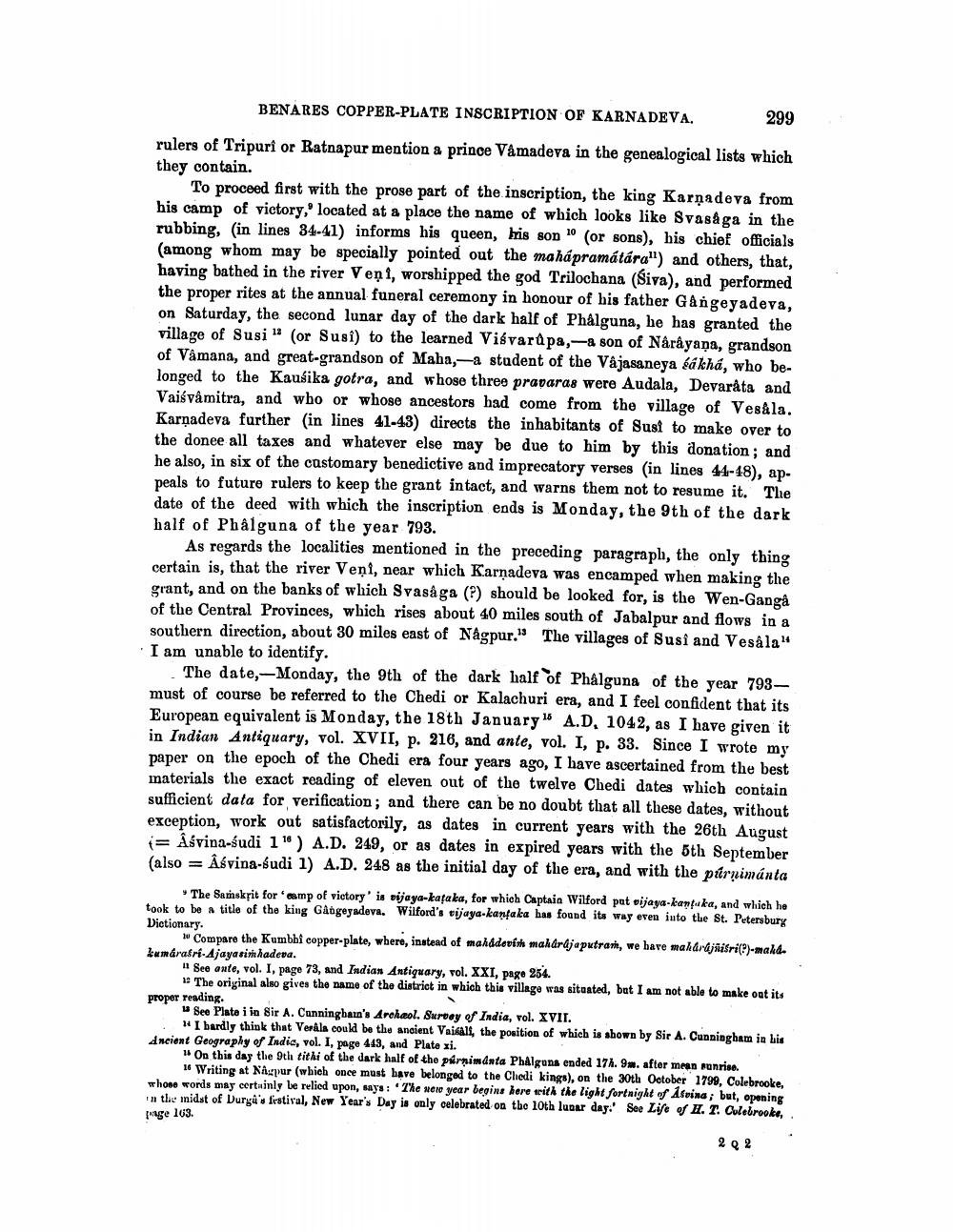________________
BENARES COPPER-PLATE INSCRIPTION OF KARNADEVA.
299
rulers of Tripuri or Ratnapur mention a prince Vamadeva in the genealogical lists which they contain.
To proceed first with the prose part of the inscription, the king Karnadeva from his camp of victory, located at a place the name of which looks like Svasaga in the rubbing, (in lines 34-41) informs his queen, his son " (or sons), his chief officials (among whom may be specially pointed out the mahápramátára") and others, that, having bathed in the river Veņi, worshipped the god Trilochana (Śiva), and performed the proper rites at the annual funeral ceremony in honour of his father Gangeyadeva, on Saturday, the second lunar day of the dark half of Phålguna, he has granted the village of Susi" (or Susi) to the learned Visvardpa,- son of Narayana, grandson of Vâmana, and great-grandson of Maha, a student of the Vajasaneya éá khá, who belonged to the Kausika gotra, and whose three praparas were Audala, Devaråta and Vaišvamitra, and who or whose ancestors had come from the village of Ves&la. Karnadeva further in lines 41-43) directs the inhabitants of Susi to make over to the donee all taxes and whatever else may be due to him by this donation; and he also, in six of the customary benedictive and imprecatory verses (in lines 44-48), appeals to future rulers to keep the grant intact, and warns them not to resume it. The date of the deed with which the inscription ends is Monday, the 9th of the dark half of Phâlguna of the year 793.
As regards the localities mentioned in the preceding paragraph, the only thing certain is, that the river Veni, near which Karnadeva was encamped when making the grant, and on the banks of which Svasaga (?) should be looked for, is the Wen-Gangå of the Central Provinces, which rises about 40 miles south of Jabalpur and flows in a southern direction, about 30 miles east of Nagpur." The villages of Susi and Vesala" · I am unable to identify.
The date,-Monday, the 9th of the dark half of Phålguna of the year 793– must of course be referred to the Chedi or Kalachuri era, and I feel confident that its European equivalent is Monday, the 18th January " A.D. 1042, as I have given it in Indian Antiquary, vol. XVII, p. 216, and ante, vol. I, p. 33. Since I wrote my paper on the epoch of the Chedi era four years ago, I have ascertained from the best materials the exact reading of eleven out of the twelve Chedi dates which contain sufficient data for verification; and there can be no doubt that all these dates, without exception, work out satisfactorily, as dates in current years with the 26th August
= švina-sudi 119) A.D. 249, or as dates in expired years with the 5th September (also = Âśvina-budi 1) A.D. 248 as the initial day of the era, and with the párnimánta
The Samskrit foremp of victory' is vijaya-kataka, for which Captain Wilford pat vijaya-kantuka, and which he took to be a title of the king Gadgeyadeva. Wilford's vijaya-kanfaka has found its way even into the St. Petersburg Dictionary.
Compare the Kumbhi copper-plate, where, instead of mahadevish maharajaputran, we have maharajšifri(?)-makekamarafri-Ajayasinhadeva.
11 See ante, vol. I, page 73, and Indian Antiquary, vol. XXI, page 254.
12 The original also gives the name of the district in which this village was situated, but I am not able to make out its proper reading.
Seo Plato i in Sir A. Cunninghaun's Archæol. Survey of India, vol. XVII.
14 I bardly think that Verla could be the ancient Vaikalt, the position of which is shown by Sir A. Cunningham in his Ancient Geography of India, vol. I, page 443, and Plate xi.
** On this day the 9th tithi of the dark half of the pirnimanta Phalgona ended 17. 9m. after mean munrise.
16 Writing at Nagpur (which once must have belonged to the Chedi kings), on the 30th October 1799, Colebrooke, whose words may certainly be relied upon, says: 'The nere year begins here teith the light fortnight of Afring; but, opening in the midst of Durga's festival, New Year's Day is only celebrated on the 10th lugar day.' See Life of H. T. Culebrooke,
fuge 103.
22




